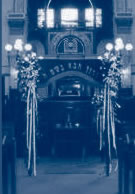|
SEDRA : SH'LACH L'CHA Hertz Chumash p.
623 Numbers Chap. 13
This week's Sedra is generously sponsored by Ken Fehily.
SYNOPSIS:
A year elapsed since the exodus and the Israelites had reached
Kadesh in the wilderness of Paran. Moses sent twelve princes,
one from each tribe, on a mission to explore the promised
land of Canaan and to report in particular on the condition
of its palace, dwelling places, soil, vegetation and fertility.
The spies crossed into the Negev and moved north till they
had explored the whole land. They returned after forty days
bringing with them huge clusters of the fruit of the land.
All concurred that the land was indeed exceedingly fertile.
However, ten of the spies expressed deep pessimism. They considered
the people to be gigantic and powerful and the cities impregnably
fortified making it impossible for them to take the land.
Joshua and Calev urged the people to have faith and with G-d's
help they would go up, vanquish the enemy and take possession
of the promised land. The people, however, sided with the
majority and became rebellious. They threatened to stone Joshua
and Calev to death and proposed finding a new leader to take
them back to Egypt.
G-d intervened intending to destroy the people and to make
a new nation from Moses' descendants. Moses successfully pleaded
with G-d not to annihilate the Israelites. Their destruction
was avoided but they were condemned to wander 40 years in
the wilderness until all this generation except Calev and
Joshua died out. A new generation would inherit the land.
The ten spies, bearers of the negative report, were consumed
in a plague. Realising their error, the people attempted to
go to Israel, and ignored Moses' warning that G-d was not
with them.
The people were defeated in an attack by the Amalikite and
Canaanite tribes living in the area.
As an assurance that the new generation will indeed possess
the land some Mitzvot which would become effective on their
entering the land were then introduced : meal offerings and
drink offerings are to accompany all offerings of animals;
the offering of the first part of dough - Challah - should
be set aside; if the congregation mistakenly practised idolatry,
atonement should be by way of a sacrifice.
A man was found violating the Sabbath by gathering wood, he
was sentenced to stoning.
The law is given that Tzitzit be worn on the four corners
of one's garments to remind the wearer of G-d's commands,
and that he should observe them.
HAPHTORAH HERTZ CHUMASH P.635 JOSHUA chap 2
The Haphtorah sees Joshua, one of the spies sent by Moses
forty years prior, now the leader of Israel poised to enter
the promised land. Connecting with the theme of the Sedra,
we are told that Joshua too sent spies to "view the land,
and Jericho". They were harboured by a woman, Rahav,
and return with an encouraging message relating how the whole
country is in awe of Israel.
TELL ME RABBI ................ PUTTING ON A TALLIT
The `Tallit', or "prayer shawl," is a four-cornered
garment or cloak to whose corners fringes (tzitzit) are affixed
as a reminder of the Lord's commandments. (Numbers 15:37-41,
which is read as the third paragraph of the Shema.)
Although four-cornered garments were common in ancient times,
to prevent the total disappearance of such a great symbolic
mitzvah, as a reminder of all other mitzvot, the wearing of
a specially-made, four cornered garment was encouraged, especially
during prayer.
The tallit is worn at every morning service, Sabbaths and
weekdays (except on Tisha B`av). The tallit is not worn at
either afternoon or evening services, except at the afternoon
service on Tisha B'av and on the night of Yom Kippur. In some
congregations it is the custom for a young man not to wear
a tallit until after his wedding day except if he is called
to the Torah or leads the service. Rabbi Jacob Mollen (1356-1427),
known as Maharil explains this custom by reference to the
proximity of two Biblical verses. One, (Deut. 22:12), reaffirms
the commandment of wearing tzitzit; the very next passage
begins with the words : "If a man taketh a wife..."
(Deut 22:13).
Most halakhic authorities find no justification at all for
this custom.
A close examination of the passage regarding the Tzitzit
(third paragraph of the Shma) reveals that they were to contain
"a cord of blue" in the fringes. A close examination
of the Tzitzit themselves reveals that in fact they are not
present on our Tallitot. The dye for the tzitzit was obtained
from a shellfish prevalent in the Mediterranean but its identity
was lost some time following the destruction of the Temple.
Ever since, the T'chelet (blue) has been missing from the
Tzitzit. In the last century, the Rhiziner Rebbe, Rabbi Chanoch
Henech Liner, claimed to have 'rediscovered' the art of making
T'chelet and he reintroduced it for his followers. His findings
were not adopted by the vast majority of the Jewish world.
Israel's second Chief Rabbi, Isaac Herzog was a keen scholar
in this subject.
I am reliably informed that religious scientists in the Gush
Etzion area have in fact rediscovered the shellfish which
is commonly eaten in Greece. The results of their research
have recently been published in a book. T'chelet has been
produced and is available ....... at a price.
The prospect though is that in time, T'chelet will again become
a usual and hopefully very affordable commodity and a sure
sign that other aspects of Jewish life too will be refreshed
by the impact of the vitality Israel has injected intoYiddishkeit.
INSTRUCTIONS FOR PUTTING ON A TALLIT
* Spread open the tallit and hold it in both hands.
* Recite the blessing.
* Throw the tallit over your shoulders in much the same way
as you would a cape.
* Before adjusting the tallit on the shoulders we momentarily
wrap the tallit around the head.
* Some worshippers wear the tallit over the head to reduce
distraction and to engender greater concentration.
* A tallit must not be taken into a bathroom but should be
removed before entering. There is no need to repeat the blessing
when one puts the tallit back on.
BACK TO SHABBAT SHALOM
TABLE
|








